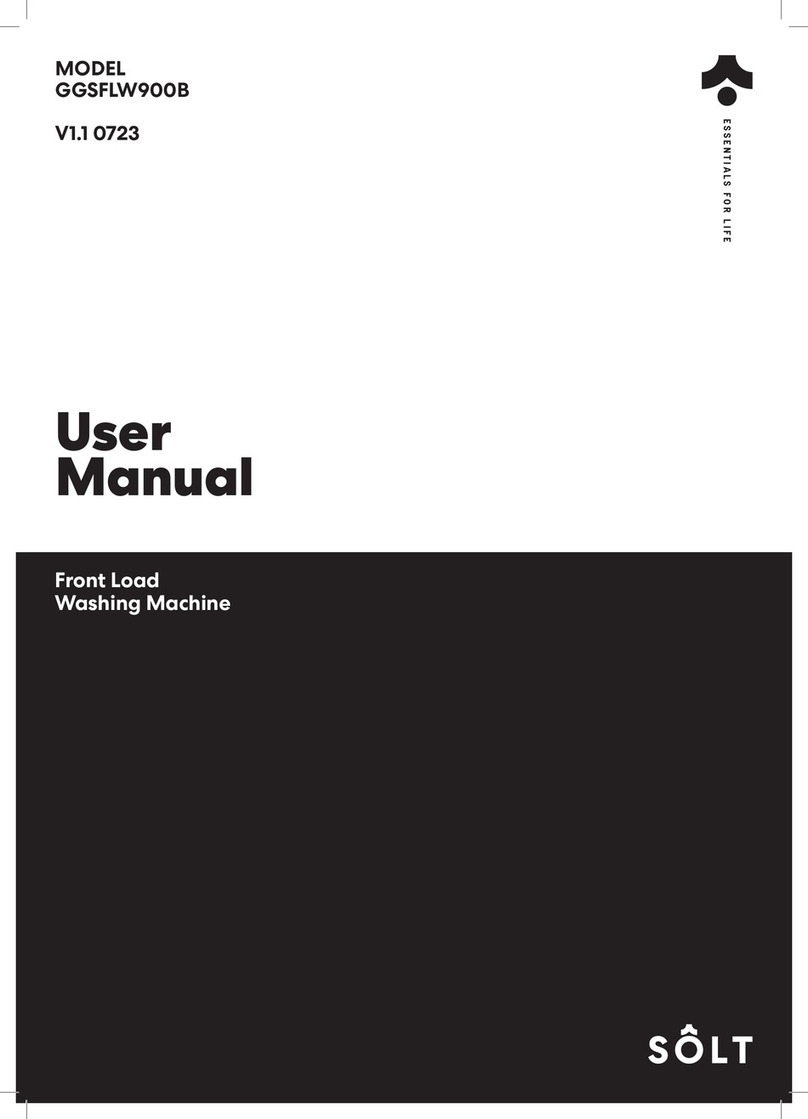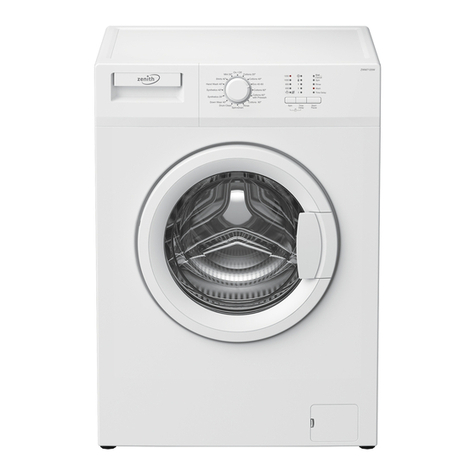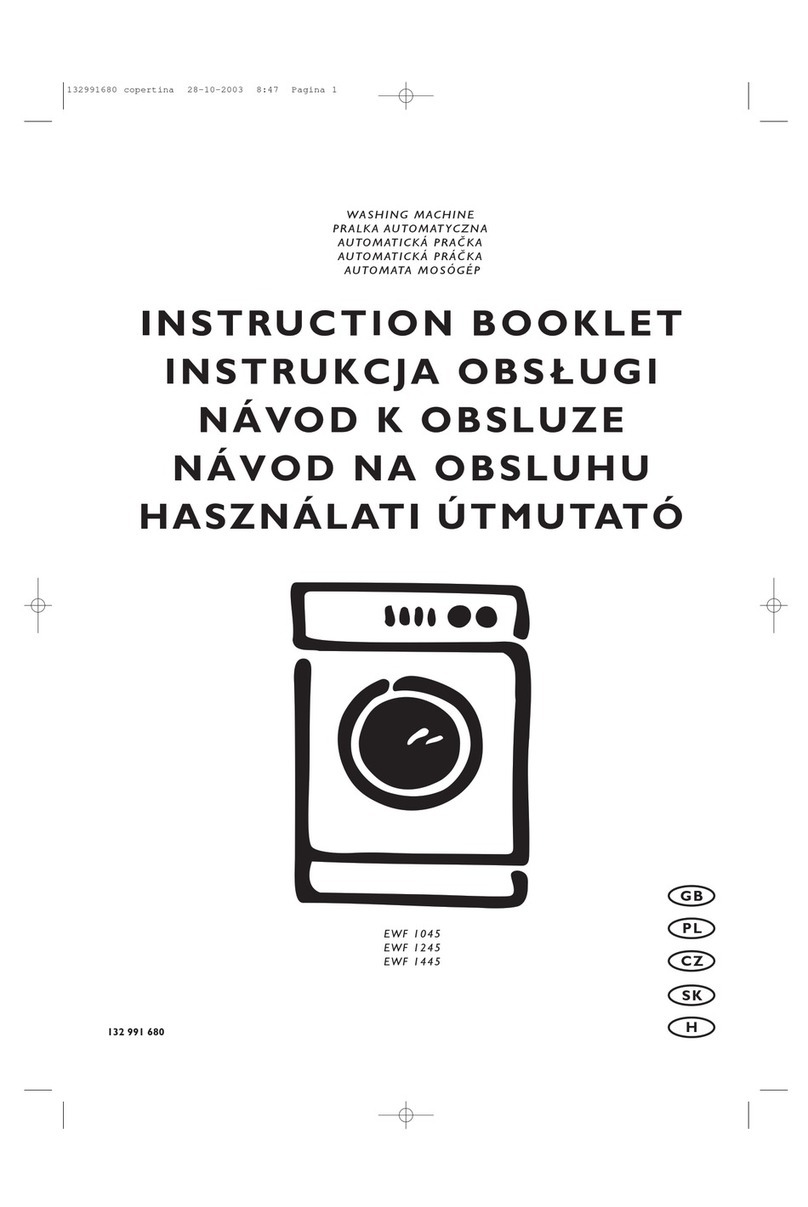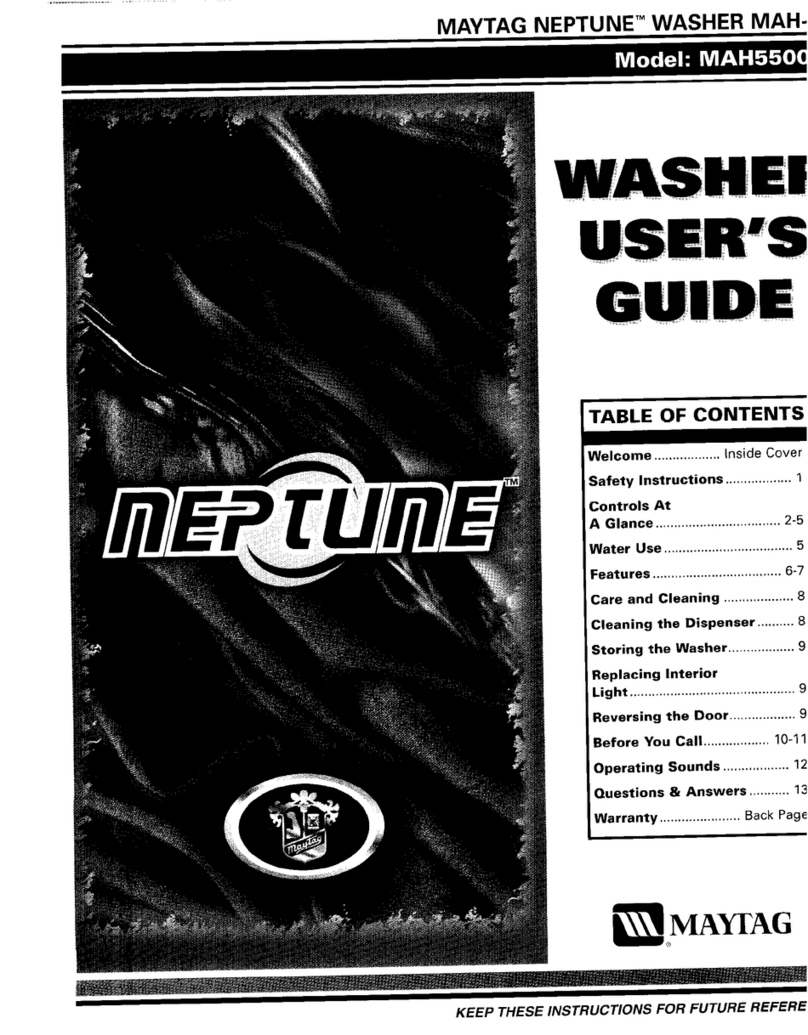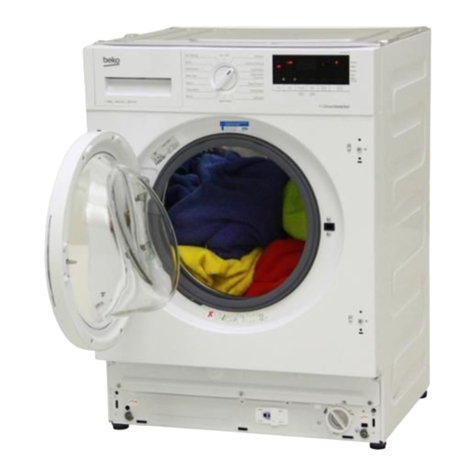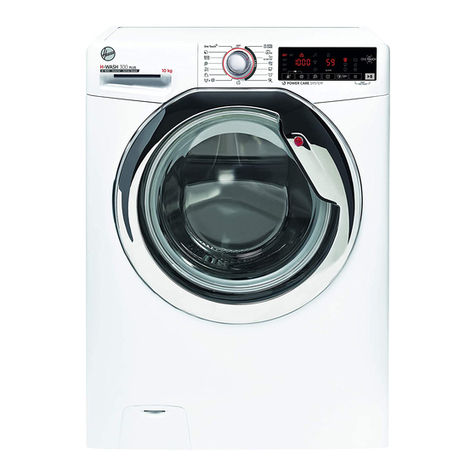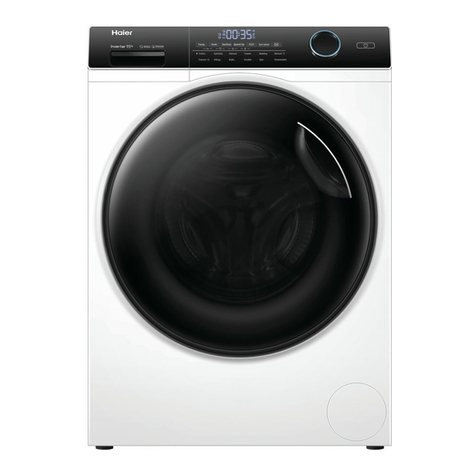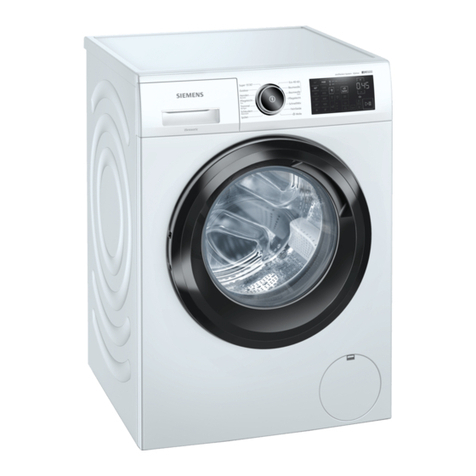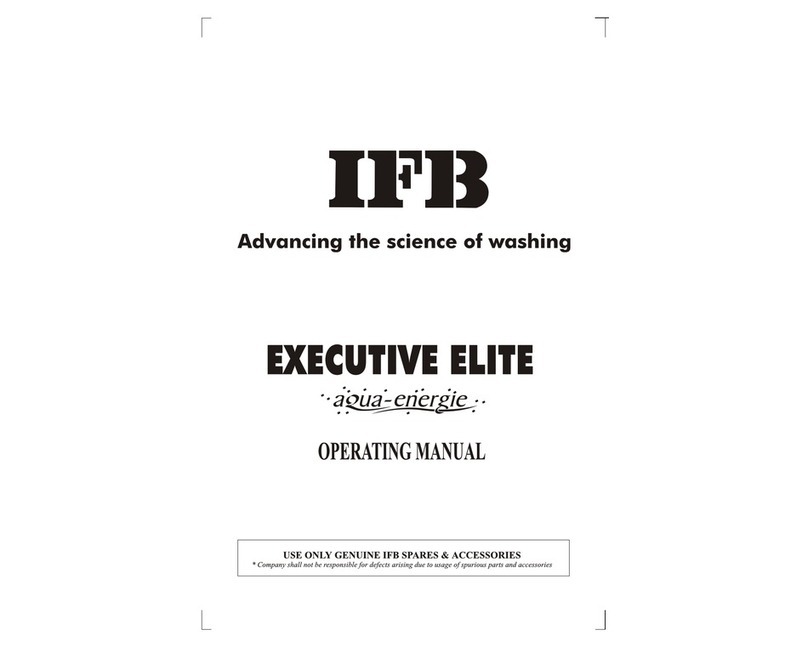Solt GGSFLW80 User manual

E S S E N T I A L S FOR LIFE
User
Manual
8kg Front Load
Washing Machine
MODEL
GGSFLW80
V 1.2 | 0121

2
For future reference, please record the following information which can be found on the rating plate and the date of
purchase which can be found on your sales invoice.
STORE DETAILS
STORE NAME
|
ADDRESS
|
TELEPHONE
|
PURCHASE DATE
|
PRODUCT DETAILS
MODEL NO.
|
SERIAL NO.*
|
Purchase Details

Welcome Congratulations on purchasing
your new Front Loader!
The Sôlt brand is proudly
distributed within Australia by
Residentia Group Pty Ltd.
Please refer to the warranty card at the rear of this manual
for information regarding your product’s parts and labour
warranty, or visit us online at www.residentia.group
At Residentia Group, we are customer obsessed and our
Support Team are there to ensure you get the most out
of your appliance. Should you want to learn more about
your Front Loader features, and importantly taking care
of your appliance when cleaning, our Support Team are
here to help.
You can use our online Support Centre at anytime by
visiting http://support.residentiagroup.com.au, or you can
contact us via calling us on 1300 11 HELP (4357).
It is important that you read through the following use and
care manual thoroughly to familiarise yourself with the
installation and operation requirements of your appliance
to ensure optimum performance.
Again, thank you for choosing an Sôlt appliance and we
look forward to being of service to you.
Kind Regards,
The Residentia Team
Residentia Group
—
Head Office.
165 Barkly Ave
Burnley
Victoria 3121
Australia
—
ACN.
600 546 656
—
Online.
residentia.group
Sôlt
—
Online.
www.solt.house
—
Instagram.
/solt.house
—
Facebook.
/solt.appliances

4
This page
is intentionally
left blank

Contents 2Purchase Details
3Welcome
6Safety Instructions
8Installation
9Your Washing Machine
11 Quick Start Guide
12 Operating Instructions
16 Cleaning & Maintenance
18 Troubleshooting
20 Technical Specifications
21 Attach Your Receipt
22 Warranty Information
Sôlt recommends the use of original spare parts. When contacting our customer service team, please ensure
that you have the following information at hand (which can be found on your appliances’ rating plate).
— Model Number
— Serial Number
T . 1300 11 4357 | E. support@residentiagroup.com.au
Customer Care

6
Safety Instructions
CONDITIONS OF USE
• This appliance is intended to be used in household
and similar applications such as farm houses or by
customers in serviced apartments, holiday apartments
and other residential type environments.
SAFETY INSTRUCTIONS
• Before the installation and use of the appliance,
carefully read the supplied instructions.
• The manufacturer is not responsible if an incorrect
installation and use causes injuries and damages.
• Always keep the instructions with your appliance for
future reference.
WARNING: To prevent any damages to your
and others’ life or property, you have to follow
the safety notes.
WARNING: Caution, risk of re!
CHILDREN & VULNERABLE PEOPLE SAFETY
WARNING: Risk of suocation, injury or
permanent disability.
• This appliance can be used by children aged from
8 years and above and persons with reduced physical,
sensory or mental capabilities or lack of experience
and knowledge if they have been given supervision
or instruction for the operation of the appliance by a
person who is responsible for their safety.
• Do not let children play with the appliance.
• Keep all packaging away from children.
• Keep all detergents away from children.
• Keep children and pets away from the appliance door
when it is open.
• Cleaning and user maintenance shall not be made by
children without supervision.
INSTALLATION
• Remove all the packaging.
• Do not install or use a damaged appliance.
• Obey the installation instruction supplied with the
appliance.
• Make sure that the oor where you install the
appliance is at, stable, heat resistant and clean.
• Always remove the plug and turn o the water supply
to the appliance after every use.
• Sharp and rigid items such as coins, nails and screws
may cause serious damage to this appliance- always
ensure pockets of clothing are empty.
• Always ensure that the drum has drained all water
before opening the appliance door. If water is visible,
do not open the appliance door.
• Do not install the appliance behind a lockable door,
a sliding door or a door with a hinge on the opposite
side, where the appliance door cannot be fully opened.
• Always be careful when you move the appliance
because it is heavy. Always wear safety gloves.
• Always move the appliance vertically.
• The rear surface of the appliance must be put against
the wall.
• This appliance should not be installed in a bathroom or
similar wet rooms, as well as rooms with explosive or
caustic gases.
• Washing machines with a single water inlet and should
only be connected to the cold water supply outlet.
Models featuring two inlet valves can be connected to
both the hot and cold water outlets.
• The appliance can be installed as freestanding or
below the kitchen counter with correct space.
• When the appliance is put in its permanent position,
check if it is fully level with the aid of a spirit level. If it
is not, adjust the feet until it is.

7
ELECTRICAL CONNECTION
WARNING: Caution, risk of re and electrical shock!
• The appliance must be earthed.
• Make sure that the electrical information on the rating
plate agrees with the power supply. If not, contact an
electrician.
• Always use a correctly installed shockproof socket.
• Do not use multi-plug adapters and extension cables.
• Make sure not to cause damage to the mains plug and
to the mains cable. Should the appliance power supply
cable need to be replaced, this must be carried out by
our Service Centre.
• Connect the mains plug to the mains socket only at the
end of the installation. Make sure that there is access
to the mains plug after the installation. Do not connect
the appliance plug with a power connection board.
• Do not pull the mains cable to disconnect the
appliance. Always pull the mains plug.
• Do not touch the mains cable or the mains plug with
wet hands.
• This appliance complies with the E.E.C. Directives.
CARE & CLEANING
WARNING: Risk of injury or damage to the appliance.
• Before maintenance, deactivate the appliance and
disconnect the mains plug.
• Do not use water spray and steam to clean the
appliance.
• Clean the appliance with a moist soft cloth. Only use
neutral detergents. Do not use abrasive products,
abrasive cleaning pads, solvents or metal objects.
PRODUCT DISPOSAL
• Disconnect the appliance from the mains supply.
• Cut o the mains cable and discard it.
• Remove the door catch to prevent children and pets to
get closed in the appliance.
APPLIANCE USE
WARNING: Risk of re, explosion, electric shock or
damage to the appliance.
• Use this appliance in a household only.
• Before operating this appliance, ensure that all
packaging and transport bolts have been removed.
Otherwise, serious damage can occur to the appliance.
• Before washing any clothes for the rst time, the
washing machine should be operated for one whole
cycle without any clothes inside.
• Do not climb up or sit on top of the appliance.
• Do not change the specication of this appliance.
• If you use fabric softener or similar products, obey the
instructions on the packaging.
• Do not sit or stand on the open door.
• Obey the maximum load volume of 8.0 kg
(refer to the “Program chart” chapter).
• Ensure all objects are removed from clothing pockets
such as lighters and matches.
• Please only use front load washing machine
detergents. Flammable and explosive or toxic solvents
are forbidden for use with this appliance. Gasoline and
alcohol should not be used as a detergent.
• Never wash carpets or rugs within the appliance.
• Be careful to avoid burns when the machine drains hot
washing water.
• After a wash program completes, please wait two
minutes before opening the door.
• If a tumble dryer is installed on top of the washing
machine, use the suitable stacking kit. The stacking
kit, available from your authorised vendor, can be used
only with the appliance specied in the instructions,
supplied with the accessory. Read it carefully before
installation (Refer to the Installation leaet).
• Never lean against the machine door.
• Please do not close the machine door with excessive
force and if you nd it dicult to close the door, ensure
that the clothing load isn’t excessive.
• Glass door may become hot during operating.
TRANSPORT
• Always move the appliance cautiously. Do not use the
machine door or the handle of the detergent dispenser,
to lift the appliance.
• Transportation bolts should be reinstalled within the
machine by a specialised person, prior to transporting
the appliance.
• Ensure that all accumulated water is drained from the
appliance before moving.

8
Installation
INSTALLATION POSITIONING
• Ensure that your appliance is installed on solid and at ground, in a level position.
• Please do not place the appliance on a slope, soft carpet or wooden oor.
• Your appliance should only be installed within an internal environment.
Do not install the appliance outdoors.
REMOVING THE TRANSPORTATION BOLTS
WARNING: Before using the appliance, the transport bolts must be removed from the
backside of this machine. Please take the following steps to remove the bolts:
• Loosen all 4 bolts with a spanner and then remove them.
• Use the plugs (supplied) to plug the holes.
• Keep the transport bolts for future use.
LEVEL ADJUSTING
• If the oor is obviously uneven, your appliance feet need to
be adjusted. If your appliance isn’t level, it will cause your
appliance to vibrate, and potentially move from its position.
• Once you’ve positioned your washing machine, press down
from the top in all four corners to ensure that it’s completely
stable (i.e. not rocking in any direction). Also use a spirit level
to ensure that it is completely level in all directions.
• Should you need to make adjustments, use a spanner to turn
the appliance legs until it makes contact with the oor. Turn
the leg using one hand and then fasten the nut up against the
appliance cabinet, to lock the leg in place.
• After making any adjustments to the appliance legs,
re-check to ensure it is level and no rocking occurring.
CONNECT THE INLET PIPE
• Connect the hose elbow to the cold water outlet, screwing in a clockwise
direction.
• Connect the other end of the inlet hose to the water inlet valve on the rear of the
washing machine.
• After installation, if there are any leaks detected, remove the hose and re-install
using the steps above. The hose is designed to be used on a standard washing
machine cock outlet.
POSITION THE OUTLET HOSE
• The outlet hose (used to drain the discharged water) is to be ideally connected
to the relevant waste pipe, although it can also be positioned to drain into a sink/
trough. Note that the outlet hose has a minimum outlet position of 60cm and a
maximum position of 100cm (as illustrated on the right).
Note: If you are positioning the outlet hose to drain into a sink or trough, please
ensure that it is xed in place and that the sink remains unblocked at all times.

9
Your Washing Machine
GGSFLW80
Water supply hose
Top cover
Control panel
Service panel
Power supply cord
Drain hose
Drum
Detergent dispenser
Door
CONTROL PANEL
1 Program selection dial 2 Display 3 Specialty function buttons 4 Start/Pause button 5 On/Off button
DISPLAY ICONS
ACCESSORIES
1 Transport hole plug 2 Supply hose cold water 3 Owner’s manual
Note: The images in this user manual are for explanatory purposes only.
Your Front Loader Washing Machine may appear slightly different, however the functions remain the same.

10
DETERGENT DISPENSER
The detergent drawer of your
washing machine is split into
three compartments:
I Pre-detergent compartment.
Refer to the Wash Programs Table
to see which programs utilise a
pre-wash.
II Main detergent compartment.
This is the common detergent
drawer.
Washing additive compartment.
Use for fabric softeners, etc.
WARNING: Detergent only need to be added in “case I” after selecting pre-washing for machines with this function.
Program
Default
Temp
(°C)
Default
Time
Default
Speed
(RPM)
– – 1400
Cotton 40 3:39 1400
Synthetic 40 3:18 1200
Baby Care 60 1:42 800
Jeans 30 1:35 1000
Mix 40 1:20 800
20°C 20 1:01 1000
Rinse & Spin –0:20 1000
Spin Only –0:12 1000
SETTING THE DELAY FUNCTION
To set the delay function:
• Select a program by turning the Program dial
• Press the Delay button to choose a time (The delaying time is 0-24H)
• Press the Start/Pause button to being your cycle
To cancel the delay function, press the Delay button until the display is back to 0H.
The delay function should be activated before starting the program.
If the program has already started, turning o the machine will reset the delay function.
Program
Default
Temp
(°C)
Default Time
Default
Speed
(RPM)
– – 1400
Intensive 40 3:48 800
ECO 40-60°C 30 0:59 800
Delicate 30 0:50 600
Wool 40 1:07 600
Sportswear 20 0:45 800
Rapid ‘45 20 0:45 800
Quick ‘15 Cold 0:15 800
Required
Optional
Your Washing Machine (Continued)
Liquid detergent Powder detergent Pull out the dispenser
10
14
Detergent Dispenser
Pull out the dispenser
Caution!
• Detergent only need to be added in "case I “after selecting pre-washing
for machines with this function.
OPERATIONS
Pre wash detergent
Main wash detergent
Softener
II
I
• As for the agglomerated or ropy detergent or additive, before they are
poured into the detergent box, it is suggested to use some water for
dilution to prevent the inlet of detergent box from being blocked and
overflowing while filling water.
• Please choose suitable type of detergent for the various washing
temperature to get the best washing performance with less water and
energy consumption.
Note!
Programme
Cotton
Synthetic
Baby Care
Jeans
Mix
20
℃
Rinse & Spin
Spin Only
Means must ○ Means optional
Programme
Intensive
ECO 40-60
Delicate
Wool
Sport Wear
Rapid 45'
Quick 15'
Program Program
Synthetic Eco 40–60° C
Jeans Wool
20°C Rapid ’45
Spin Only
Cotton Intensive
Rinse & Spin Quick ’15
Baby Care Delicate
Mix Sportswear

11
Quick Start Guide
QUICK START:
Follow the procedure below to operate your washing machine.
1. Install your washing machine.
2. Turn on the water supply.
3. Plug in the power supply.
4. Open the door and load in the laundry.
5. Close the machine door.
6. Measure the detergent and pour in the appropriate amount.
7. Select the desired program.
8. Select any additional functions if required.
9. Press the Start/Pause button to begin.
10. Completion of the washing cycle.
• At the completion of a wash program, the washing machine will make an audible tone.
11. Turn o the water supply
• Although the washing machine would be switched o, the power
outlet should be switched o and the plug should be pulled out for safety reasons.

12
Operating Instructions
PREPARATION BEFORE WASHING CLOTHES
Please follow these steps carefully to avoid trouble with your washing machine and damaging your clothing.
Washing Considerations
• New clothes in particular, can leach colour onto other
clothing items, particularly whites.
Consider washing these and bright colours separately.
• Stained clothing should be treated with a stain
remover, prior to washing.
• Temperature sensitive clothes should be washed in
accordance with their care direction label. Otherwise
distortion and/or changes in colour could occur.
• Never allow washing to sit in the machine for a long
period of time- particularly when wet. Clothes can
become mouldy and develop an odour.
• Certain clothing cannot be washed in a washing
machine and their care directions may state dry
cleaning or hand washing required.
• Wrinkle style clothes, embossed clothes, resin clothes,
etc may become distorted when immersed in water.
• Avoid washing clothes without care direction labels
within the appliance, to be safe.
• Always remove all items from clothing pockets, as hard
items can cause damage to the appliance.
• Try to wash clothing colours and sizes in like loads,
as this will improve the eectiveness of the washing
and results.
• Close all clothing zips and ensure all buttons are
fastened securely.
• Delicate items such as bras, handkerchiefs and ties
should be washed within a special washing bag, to
prevent damage to themselves and other clothes.
• When washing a large single item that could become
heavy (i.e. a towel or jacket), it can cause the appliance
to become unbalance during its spin cycle. Therefore
it’s recommended to add one or two more clothing
items to help the machine balance.
• Try to remove any pet hair, dust and stains from
clothing prior to washing.
• Baby clothing should be washed separately.
• Clothing that gets easily “fuzzed” or loses bres easily,
should be washed separately.
• Black clothing items should be washed separately.
• Do not wash waterproof materials within the
washing machine.
Pay Attention to Detergents
• Only use suitable front load washing machine
detergents with this appliance. Powders and liquid
detergents only.
• Only ever use the recommended quantity of detergent,
as per the manufacturer’s guidelines, as an excessive
quantity can cause excessive bubbles and overow to
occur.
• It can also result in detergent residue remaining on the
clothing after completion of the wash cycle.
WARNING: Always keep detergents and additives out
of reach from children.
Clothing Classications
The symbol types on care labels are typically classied
into the following textiles: Cotton, Blended Fiber, Synthetic
Fiber, Silk, Wool and Articial Fiber.
Conrm the Washing Capacity
Never load the machine with excessive weights, as it will
aect your washing results.
Fiber type Maximum Load Capacity
Cotton 8.0kg
Synthetics 4.0kg
Wool 2.0kg
Delicates 2.5kg

13
WASHING CLOTHES FOR THE FIRST TIME
Before washing any clothes, please perform one cycle
without clothes inside as follows:
• Connect the power source and water.
• Insert a small amount of detergent into Compartment II
of the detergent drawer and close it.
• Select a washing program.
• Press the “Start/Pause” button on the appliance.
• Allow the program to complete and your washing
machine is now ready for use.
SELECTING A PROCEDURE
You should select you washing program based on the type
of clothing, quantity and dirtiness level, in combination
with the following temperature table.
Temperature Mode Application
90ºC Seriously soiled clothing, pure white cotton
(I.e. bed linen, towels, table cloths, etc)
60ºC
Moderately soiled clothing, cotton and
synthetic articles with certain decolourising
degree (I.e. shirts, pajamas, etc)
40ºC, 30ºC,
20ºC, Cold Water Lightly soiled clothing, synthetics and wool
To select a program:
• First turn the Program Selection Dial to the
corresponding wash program, according to the type
of textiles being washed.
• Secondly, select the desired temperature based on
the level of dirtiness.
Note: Generally the higher the temperature, the more
power that’s consumed.
• Finally, select your desired spin speed. The higher the
spin speed, the drier the textiles will be at completion,
however more delicate textiles will be more wrinkled.
Delicate textiles should be set with a lower spin speed.
Selecting the main washing program depend on the types
of clothing to be washed, as follows:
Cotton
To increase the washing results, the main washing time
is increased. It is recommended for washing clothes for
babies or worn by the persons with skin allergies. It is
recommended for washing durable cotton articles, for
example: bed sheets, quilt covers, pillowcases, gowns,
underwear, etc.
Synthetic
The procedure is shorter compared with that for cottons
and the washing intensity is relatively gentle. It is
recommended for washing synthetic articles, for example:
shirts, coats, etc.
Baby Care
Washing the baby’s clothes, it can make the baby’s wear
cleaner and make the rinse performance better to protect
the baby skin.
Jeans
You can select this procedure for washing jeans.
Mix
You can select this procedure for washing durable clothes,
that typically require more wash time and intensity. It is
ideal for any “daily” clothing such as cotton, including
sheets, pillowcases, bathrobes and underwear.
20°C
You can select this procedure for washing delicate
items where the care label suggests Cold Wash.
To be used with only a small quantity of clothing at
a time with light soiling only. The default temperature
of this washing procedure is 20°C.
Rinse & Spin
This procedure provides a short rinse cycle followed by a
spin cycle.
Spin Only
This procedure provides a spin only option. Residual soapy
water shall be drained out before spinning.
Intensive
You can select this procedure for a intensive cycle.
Suitable for washing heavily soiled clothing or items.

14
Operating Instructions (Continued)
ECO 40–60°C
This procedure saves energy and limits the washing
temperature to 40°C or 60°C. Use with a small quantity of
clothes which are only lightly dirty.
Delicate
You can select this procedure to wash your delicate
clothes. Its washing intensity is gentler and spin speed
is low compared with the “Synthetic” procedure. It is
recommended for washing any articles requiring a soft
wash.
Wool
You can select this procedure to wash wool textiles
labeled with “Machine Wash”. Please select the proper
washing temperature according to the clothings care label.
Furthermore, the proper detergent amount should be used
for wool textiles, which is generally less than normal wash
loads.
Sportswear
You can select this procedure for washing sport and active-
wear clothing.
Rapid 45’
This procedure is suitable for washing a small quantity of
clothes without heavy soiling.
Quick 15’
You can select this procedure for washing a small quantity
of clothing, where items are only lightly soiled.
Your Cycle
The Your Cycle function can be used to dene and save
your favourite drying program for easier selection in the
future (i.e. Use this function to save your most frequently
used drying settings).
To set the Your Cycle function:
• Use the program selector dial to select your required
program and select any other drying functions.
• Press and hold the “Spin Speed” button for 3 seconds
until the display ashes, indicating that your desired
program has been saved.
• To use your preset Your Cycle, simply turn the program
selector dial to the Your Cycle position and press the
“Start/Pause” button to begin.
• If you wish to change your Your Cycle settings, simply
repeat the steps above at any time.

15
ADDITIONAL WASH OPTIONS
Prewash Function
The Prewash function adds an additional wash prior to the
main wash. Extra detergent should be placed in the
Pre-wash detergent compartment, labeled with “I”.
Speed Wash Function
Adding this function to your wash program decreases the
washing time.
To activate the Speed Wash Function:
• Select your desired washing program.
• Press the “Speed Wash” button.
• Press the “Start/Pause” button to begin the program.
Extra Rinse Function
The laundry will undergo an extra rinse cycle at the
completion of the program.
Delay Function
The Delay function can be set with this button, where the
delay is 0-24 Hrs.
To set the Delay function:
• Select a wash program;
• Press the Delay button to choose the time;
• Press Start/Pause to commence the delay operation.
To Cancel the Delay function:
• Press the Delay button until the display shows 0H. It
should be pressed prior to starting the program. If the
program has already started, press the On/O button
to reset.
Reload (Add a Garment) Function
This function can be executed during operation of a
washing program. When the drum of the machine is still in
motion and/or there is a large amount of water inside, the
machine will not allow the door to be opened.
To use the Reload function:
• Press and hold the Start/Pause button for 3 seconds.
• Once the drum stops rotating, the door will unlock
and allow you to open.
• Add your additional clothing items and close the door.
• Press the Start/Pause button once again to continue
the wash program.
Child Lock
To avoid the washing procedure being altered by children,
you can activate the child lock function. All buttons and
dials won’t alter the machines settings, however the On/O
button will still function.
Note:
If the machine is switched o when Child Lock is active, it
will remain in Child Lock mode when switched back on.
To activate or deactivate the Child Lock:
• Press and hold the “Rinse” and “Pre Wash” buttons
together at the same time for 3 seconds, whilst the
machine is operating.
• The machine will make an audible tone to let you know
that the Child Lock is activated or deactivated.
Note:
At the completion of a wash program, the child lock will
become deactivated automatically.
Bubble Removal Function
When excessive detergent is used, excessive bubbles may
occur, eecting your wash results. Your washing machine
will automatically check for excessive bubbles and work to
remove them as required.
Muting the machine (Signal function)
This function allows you to turn the audible tone on or o,
to indicate that your washing program is complete. By
default the audible signal is set to On.
When the Signal function is on, your appliance will make
an audible tone when:
• The extra function buttons are pressed
(i.e. Speed Wash, Anti-Crease).
• If the washing machine is operating and the program
selector knob is turned, the appliance will make an
audible tone to alert the user that an invalid choice has
been made.
• At the completion of a washing program, an audible
tone will sound.
To activate or deactivate the Signal function:
• Press and hold the “Extra Rinse” and “Pre Wash”
buttons together for 3 seconds.

16
Cleaning & Maintenance
CLEANING PROCEDURES
WARNING: Before beginning any cleaning or maintenance,
always ensure the appliance is switched o, the power
plug is removed from the power outlet and the water
supply has been closed.
CLEANING THE WASHING MACHINE EXTERIOR
Proper maintenance of your washing machine will keep it
looking as new and extend its working life.
• The exterior surface can be cleaned with household
cleaners and a soft damp cleaning cloth.
• If there is any residual water at the completion of a
washing program, please use a cloth to wipe it o
immediately.
Note: Never use solvents or harsh cleaning chemicals on
your washing machine’s exterior.
CLEANING THE INTERNAL DRUM
Should any rust form on the inside drum (i.e. water was
left to sit for an extended period of time), please remove
immediately using a chlorine free detergent. Never use
steel wool or a harsh abrasive.
FROZEN WASHING MACHINE
Should the temperature drop below zero and your washing
machine becomes frozen, you should:
• Disconnect the power supply for the washing machine.
• Wash the tap connection with warm water, to help you
to disconnect the inlet pipe.
• Remove the inlet pipe and immerse in warm water
(i.e. within a bathtub).
• Pour some warm water into the washing machine drum
and wait for approximately 10 minutes.
• Reconnect the inlet pipe to the tap and washing
machine and open the water supply.
• Wait until the room’s ambient temperature returns
to above 0°C before trying to operate the washing
machine.
CLEANING THE DETERGENT DRAWER
You should periodically follow these steps to ensure the
detergent drawer remains clean.
• Press down on the arrow, located on the cover for the
fabric softener compartment of the detergent drawer.
• Lift the clip up and remove the fabric softener
compartment cover.
• Wash all grooves with warm water.
• Re-install the fabric softener compartment cover
into the detergent drawer, and push the drawer back
into position.

17
CLEANING THE INLET FILTER
You should clean the inlet lter periodically, or if you nd
that insucient water is being supplied to your washing
machine when the supply tap is open.
To clean the inlet lter:
• Close the water supply tap.
• Select any wash program (except for Spin Only or
Drain Only) and press the Start/Pause button. Allow
the program to run for about 40 seconds.
• Remove the inlet pipe from the closed tap and use
water to wash the lter.
• Reconnect the inlet pipe to the tap.
To clean the washing machine lter:
• Screw o the inlet pipe from the rear of the washing
machine.
• Pull out the lter with long nose pliers, wash it
thoroughly with water and re-install the lter.
• Reconnect the inlet pipe to the rear of the washing
machine.
• Open the water supply at the tap and ensure there is
no water leakage.
• Once nished, close the water supply tap.
Note: Generally the tap inlet lter is washed rst followed
by the washing machine lter. If only the washing machine
lter is washed, then you should still follow steps 1-3 for
cleaning the inlet lter rst.
CLEANING THE DRUM PUMP FILTER
REMOVING FOREIGN OBJECTS
WARNING: To avoid the risk of an electric shock, always
remove the power plug from the power
outlet before cleaning the Drain Pump lter.
Periodically you should clean the drain pump lter to
ensure normal operation of your washing machine. The
type of washing, frequency and soil level of your washing
cycles will alter how often this procedure needs to be
undertaken, however you should inspect the lter regularly.
Should your washing machine not empty and/or spin, or
your machine makes unusual noises during
operation, your Drain Pump lter could be blocked. Follow
this procedure to check or remove any
foreign objects.
• After disconnecting the power, open the lter cover at
the front base of your washing machine.
• Unscrew the lter in an anti-clockwise direction and
remove any foreign objects.
• Re-install the lter and close the service panel.
WARNING: Never remove the pump cover when the
washing machine is in operation, always wait until the
appliance has nished and the is empty. There can be hot
water within the pump, so be careful to avoid burns, should
it have operated recently. When replacing the cover, be
careful to ensure it is closed securely.

18
Troubleshooting
WARNING
Only authorised technicians can carry out repairs.
Before contacting our customer service team, please refer to the table below to see if your fault can be xed by
yourself. Should a service technician visit be arranged and its found there are no faults with the appliance, a call out
charge will apply.
PROBLEM SOLUTION
Washing Machine
won’t start-up
• Check that the mains plug is inserted and switched on at the power point.
• Check that the door is closed securely.
• Check that the relevant fuse hasn’t blown.
• Check that the On/O button has been pressed.
• Check that the water supply tap has been opened.
Door won’t open • The machine’s safety protection is working. Disconnect the power and reconnect the power.
Heating fault • The NTC is damaged and/or the heating pipe is aging. You should be able to wash the clothes
normally however without the water heating. Please contact our customer service team.
Water is leaking
• The drainage waste pipe may be blocked.
• Check and fasten all water connection pipes.
• Inlet or Outlet hoses may be damaged. Please check.
Water is overflowing from the
base of the machine
• Check that the inlet pipes are connected firmly at the rear of the machine.
• Check that the outlet hose hasn’t been damaged.
Display isn’t lighting up • Check that the power isn’t disconnected.
• PC board may have issues. Please contact our customer service team.
Detergent residues remain in
the detergent drawer
• Ensure you are using a correct amount of detergent.
• Follow the cleaning steps to remove any damp residual detergent from the drawer.
Washing results aren’t
to expectations
• Ensure you are using a sucient amount of detergent.
• Ensure the correct quantity of clothes are being used depending on the wash program selected.
• Ensure you are using the correct wash program to suit the clothing and level of dirtiness.
• Try using an alternative detergent.
Washing machine is making an
abnormal noise or vibrating
• Ensure the washing machine is level.
• Ensure that all transportation bolts have been removed.
• Ensure the appliance has been installed on a solid and level floor.
• Ensure that all legs are making contact with the floor and adjust as required.
• Follow the Drain Pump cleaning procedure and ensure there are no foreign objects.
Note: If the above steps don’t resolve your issue or you cannot resolve the fault by yourself:
• Press the “On/O” button.
• Switch o the appliance at the power outlet and remove the plug.
• Call our customer service team.

19
INDICATION PROBLEM SOLUTION
E30 Door is not closed properly • Restart after the door is closed
• Check if there are clothes or washing articles stuck
E10 Water injecting problem
while washing
• Check if the water pressure is too low
• Straighten the water pipe
• Check if the inlet valve lter is blocked
E21 Overtime water draining • Check if the drain hose is blocked
E12 Water overow • Restart the washer
Note: If the above steps don’t resolve your issue or you cannot resolve the fault by yourself:
• Press the “On/O” button.
• Switch o the appliance at the power outlet and remove the plug.
• Call our customer service team.

20
Technical Specifications
Below outlines the technical specications for your Washing Machine.
Washing Capacity 8.0kg
Dimensions (W � D � H mm) 595 � 565 � 850 mm
Net Weight 71kg
Rated Power 2000W
Power Supply 220-240V, ~50Hz, 10Amp
Standard Water Pressure 0.05MPa~1.0MPa
Max Noise Level (Washing/Spinning) 54dbA / 76dbA
NOTE:
This product is subject to continuous improvement, specication are subject to change without prior notice.
This product was tested in accordance with AS/NZS 2040.2 and AS/NZS6400 using program:
“Cotton Eco 60”, which is the program recommended for a normally soiled cotton load at rated capacity.
Table of contents
Other Solt Washer manuals

Solt
Solt GGSTLW100RCW User manual
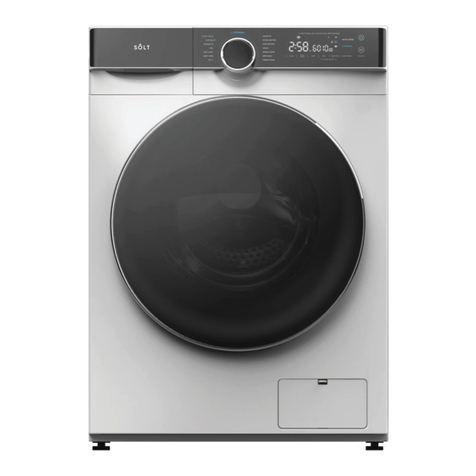
Solt
Solt GGSFLW80ADW User manual
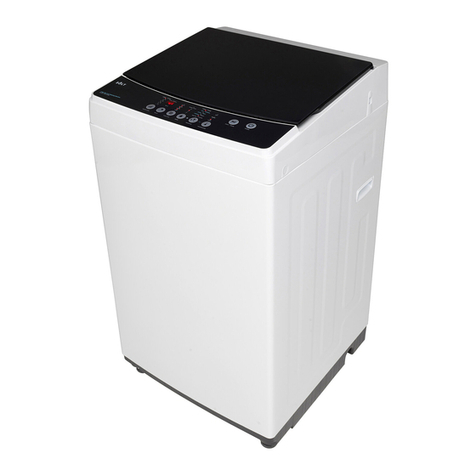
Solt
Solt GGSTLW70B User manual
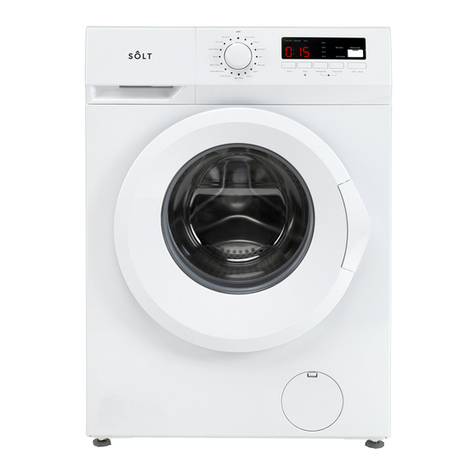
Solt
Solt GGSFLW606 User manual

Solt
Solt GGSTLW70RC User manual
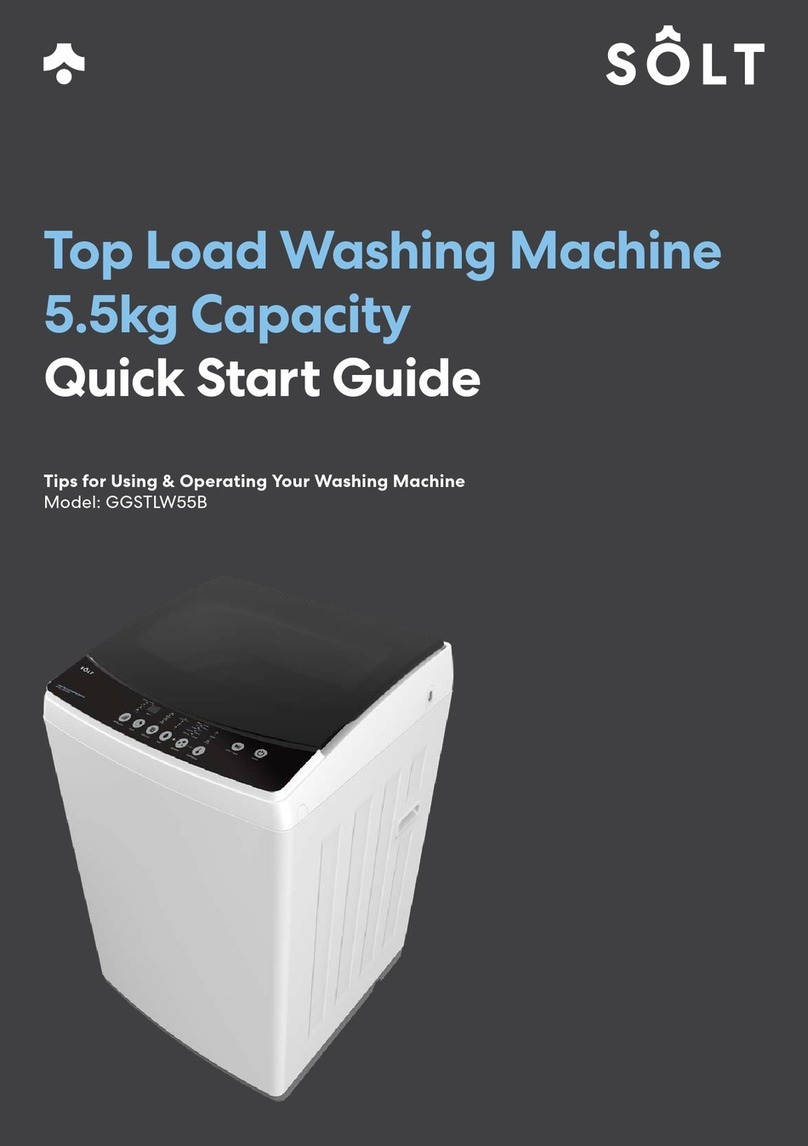
Solt
Solt GGSTLW55B User manual

Solt
Solt GGSTLW100RCTG User manual
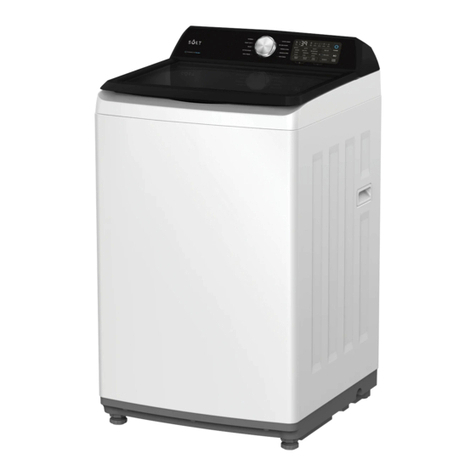
Solt
Solt GGSTLW1202RC User manual
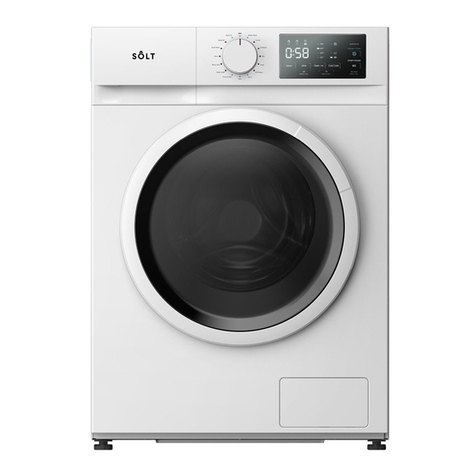
Solt
Solt GGSFLW600 User manual

Solt
Solt GGSFLW600 User manual
Popular Washer manuals by other brands
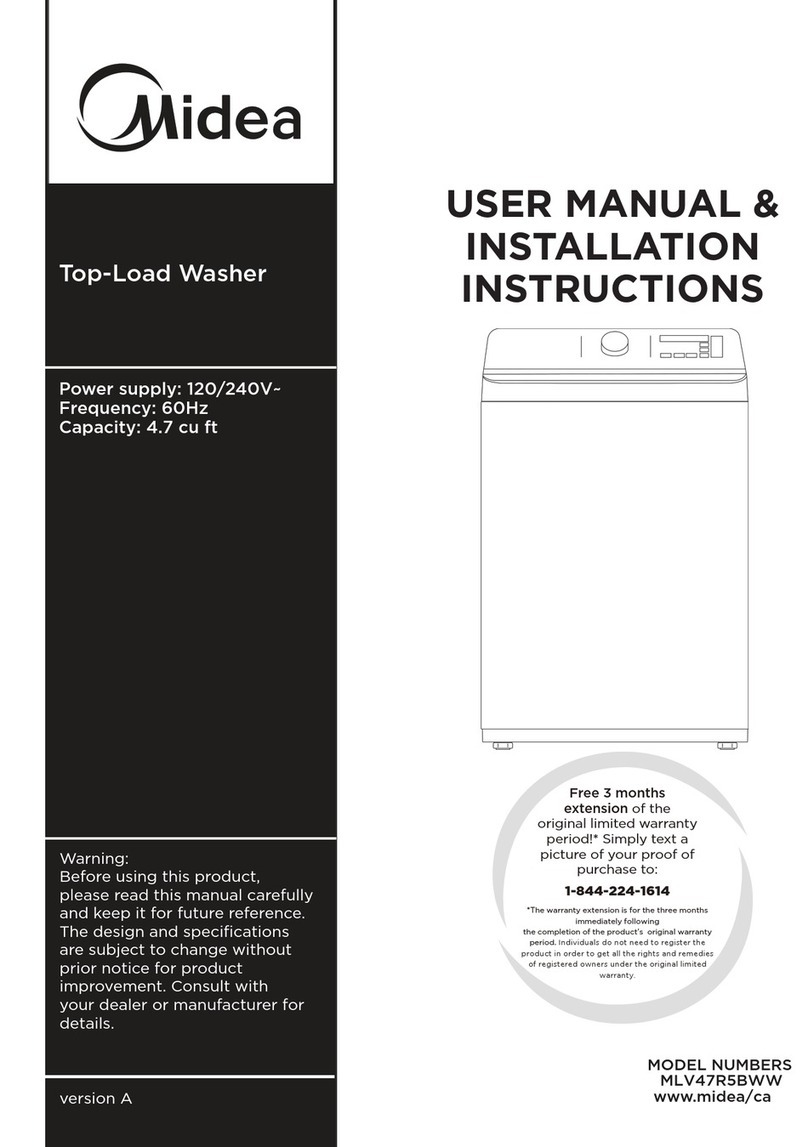
Midea
Midea MLV47R5BWW User's manual & installation instructions
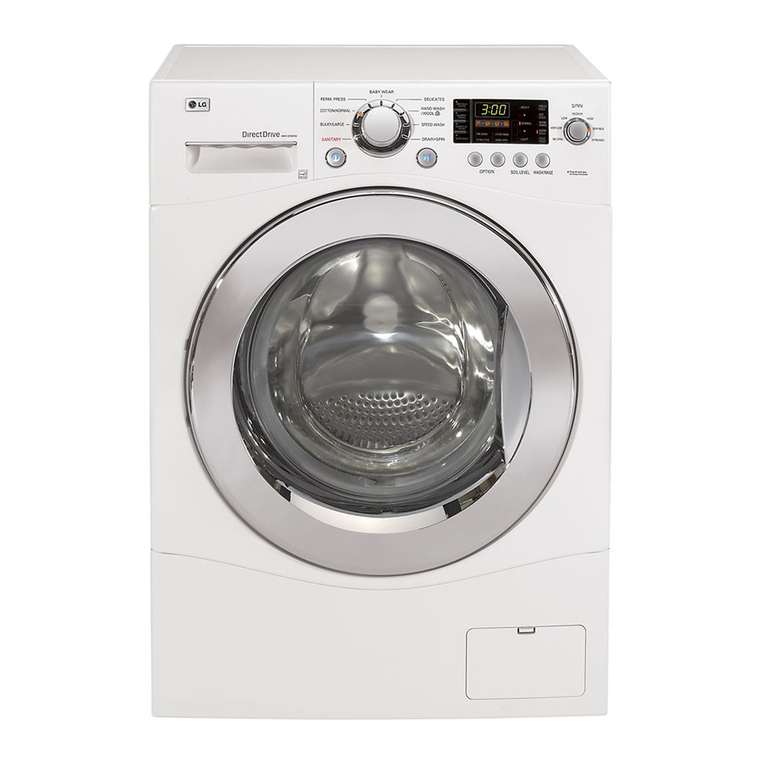
LG
LG WM1355HW User's guide & installation instructions

Samsung
Samsung WA50F9A6DS SERIES Service manual

Activa
Activa 840 AC User instructions
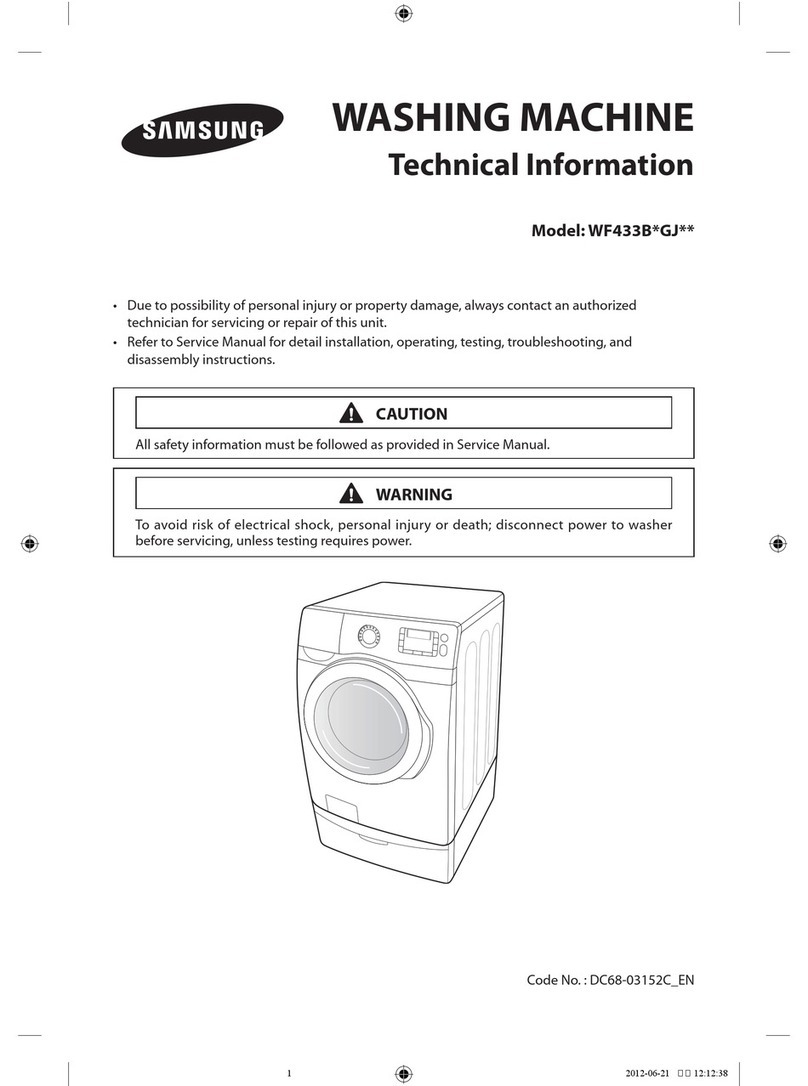
Samsung
Samsung WF433BTGJWR/A1 technical information

Bosch
Bosch WAV28K40AU User manual and assembly instructions

